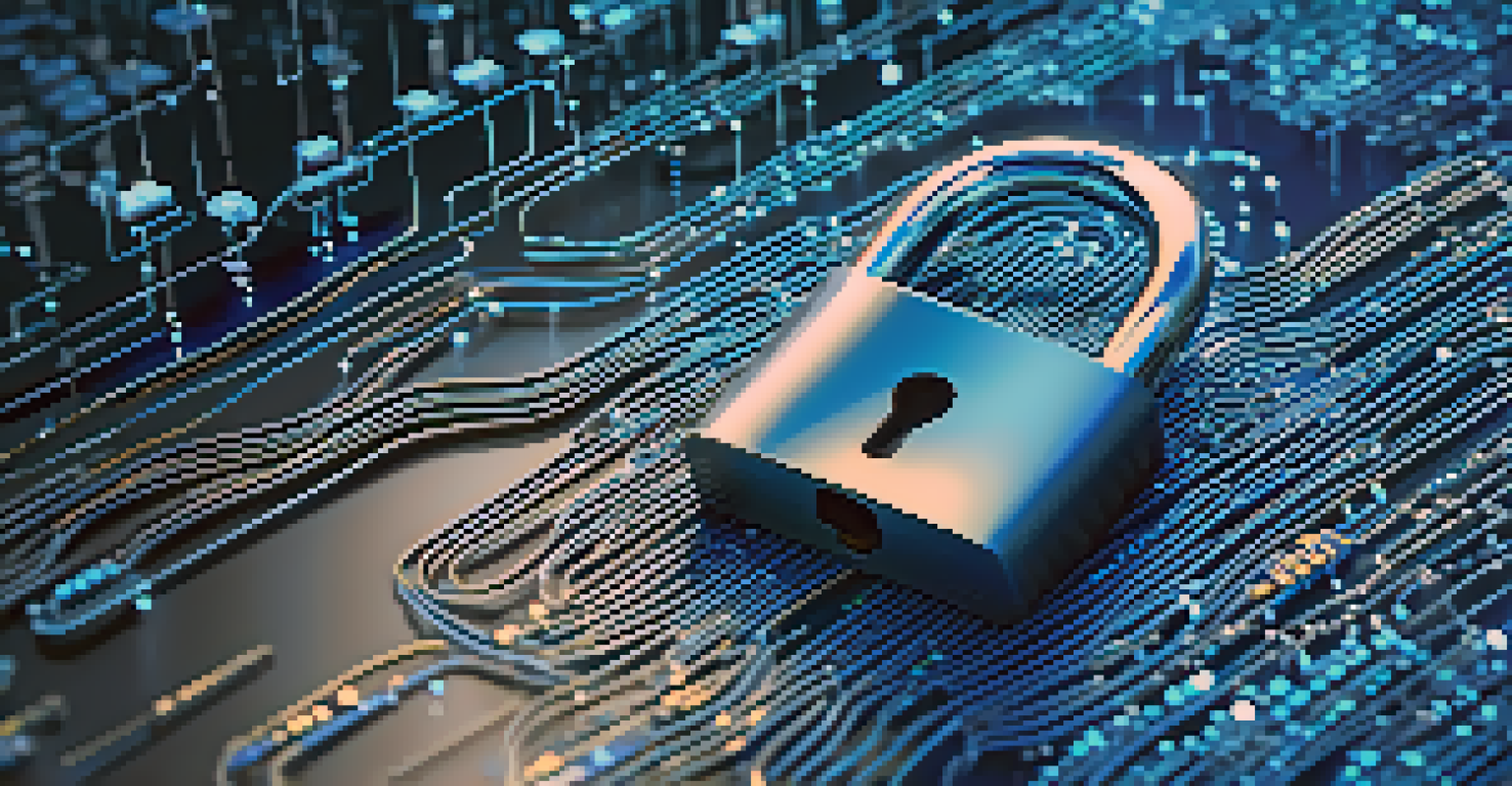AI Solutions for Protecting Data in Internet of Things (IoT)

Understanding the Importance of Data Security in IoT
As the Internet of Things (IoT) continues to expand, the importance of data security becomes increasingly clear. With billions of connected devices collecting vast amounts of data, vulnerabilities can lead to serious breaches. Imagine a smart home where a hacker gains access to personal information simply through an unsecured thermostat. This scenario highlights the pressing need for robust security measures in IoT environments.
Data is the new oil. It’s valuable, but if unrefined, it cannot really be used.
The interconnected nature of IoT devices means that a single weak link can jeopardize the entire network. Data breaches can result in not just financial loss, but also reputational damage and privacy violations. For businesses, this translates to a loss of customer trust, which can be hard to regain. Therefore, identifying and implementing effective security solutions is critical.
AI technology emerges as a powerful ally in fortifying IoT data security. By leveraging machine learning algorithms, AI can analyze patterns and detect anomalies that may indicate security threats. This proactive approach to data protection is essential as traditional security measures might struggle to keep pace with the rapid evolution of IoT devices.
How AI Enhances Threat Detection in IoT Systems
One of the standout benefits of AI in IoT security is its ability to enhance threat detection. Traditional security systems often rely on predefined rules, which can miss emerging threats. In contrast, AI uses advanced algorithms to learn from data continuously, identifying unusual behavior and potential risks. Imagine a security guard who not only watches for intruders but also learns to recognize suspicious activity over time.

For instance, if a device suddenly starts sending data at an unusual frequency, AI can flag this behavior as potentially malicious. This real-time analysis allows for quicker responses to threats, minimizing the potential damage. By automating threat detection, AI reduces the burden on human operators, allowing them to focus on more complex issues.
Data Security is Essential in IoT
As billions of connected devices collect data, robust security measures are crucial to prevent breaches and protect user privacy.
Moreover, AI's ability to adapt and learn means that the security systems can evolve alongside new threats. As cybercriminal tactics change, AI can adjust its algorithms to keep up, providing a dynamic layer of protection for IoT networks. This adaptability is crucial in an environment where threats are constantly emerging.
The Role of AI in Data Encryption for IoT Devices
Data encryption is a fundamental aspect of securing sensitive information, and AI can play a pivotal role in enhancing this process. In the realm of IoT, where devices often have limited processing power, traditional encryption methods may not be feasible. AI can optimize encryption algorithms, making them more efficient without compromising security. Picture a lock that not only secures your home but also gets smarter each day.
The future is already here — it's just not very evenly distributed.
By using AI to analyze data patterns, organizations can implement encryption strategies that are tailored to specific risks. For example, AI can determine which data is most sensitive and ensure that it is encrypted with stronger algorithms. This targeted approach helps to mitigate risks while maximizing performance.
Additionally, AI can automate the management of encryption keys, a task that is often cumbersome. By continuously monitoring for unusual access patterns, AI can adjust keys dynamically, reducing the chances of unauthorized access. This not only enhances security but also simplifies the encryption process for IoT deployments.
AI-Powered Authentication Methods for IoT Devices
Authentication is crucial in ensuring that only authorized users and devices can access IoT networks. Traditional methods, like passwords, can be vulnerable to attacks, making them less effective in the evolving threat landscape. AI introduces innovative authentication techniques, such as biometric recognition and behavioral analysis, which can significantly enhance security. Think of it as a personalized bouncer who knows exactly who belongs and who doesn’t.
For example, AI-driven systems can analyze user behavior, recognizing patterns such as typing speed or device usage habits. If a login attempt deviates from the established norm, the system can trigger additional verification steps. This kind of adaptive authentication not only strengthens security but also improves user experience by minimizing friction.
AI Enhances Threat Detection
AI's ability to identify unusual behavior in real-time allows for quicker responses to potential security threats in IoT systems.
Moreover, AI can facilitate device-to-device authentication in IoT ecosystems. By enabling secure communication between devices, AI helps to ensure that only trusted devices can interact with each other. This interconnected authentication process is vital in maintaining the integrity of the entire network.
Using AI for Predictive Analytics in IoT Security
Predictive analytics powered by AI can revolutionize IoT security by anticipating potential threats before they occur. By analyzing historical data and identifying patterns, AI can forecast when and where vulnerabilities might arise. Imagine having a weather app that not only tells you the forecast but also warns you of impending storms based on previous weather data.
This proactive approach allows organizations to bolster security measures in anticipation of threats. For instance, if data indicates that a specific device is frequently targeted, security teams can implement additional safeguards. This shift from reactive to proactive security not only minimizes risks but also optimizes resource allocation.
Furthermore, predictive analytics can help organizations identify weak points in their IoT infrastructure. By understanding where vulnerabilities are likely to occur, teams can prioritize their efforts in strengthening those areas. This strategic focus can significantly enhance overall IoT security.
Challenges AI Faces in Securing IoT Data
While AI offers significant advancements in IoT data security, it is not without its challenges. One major concern is the potential for adversarial attacks, where cybercriminals manipulate AI algorithms to bypass security measures. This cat-and-mouse game between attackers and defenders highlights the need for continuous improvement in AI security protocols. It's akin to a chess match, where both sides must anticipate each other’s moves.
Additionally, the complexity of IoT environments can make it difficult for AI systems to function effectively. With a vast array of devices, each with unique characteristics, ensuring consistent security across the board can be daunting. Organizations must invest in training AI systems with diverse datasets to enhance their accuracy and reliability.
Future of AI in IoT Security
The integration of AI in IoT data protection is expected to evolve with new technologies, enhancing security measures and collaboration.
Moreover, data privacy regulations pose another challenge. AI systems often require access to large amounts of data for training, which can conflict with privacy standards. Striking the right balance between effective AI implementation and compliance with regulations is crucial for the success of IoT security strategies.
Future Trends of AI in IoT Data Protection
Looking ahead, the integration of AI in IoT data protection is expected to grow significantly. As IoT devices become increasingly widespread, the need for advanced security solutions will escalate. Experts predict that AI will not only enhance existing security measures but also pave the way for entirely new approaches. This evolution will be comparable to the way smartphones transformed communication.
Emerging technologies, such as quantum computing, may also play a role in shaping the future of AI-powered IoT security. Quantum encryption, paired with AI analytics, could provide unprecedented levels of security, making it nearly impossible for hackers to breach IoT networks. The potential for this synergy is enormous, promising a new era of data protection.

Additionally, as AI continues to evolve, we may see the rise of decentralized security models. These models would allow IoT devices to share threat intelligence in real-time, creating a collective defense system. This collaborative approach could significantly enhance the overall security landscape, ensuring that IoT networks remain resilient against emerging threats.